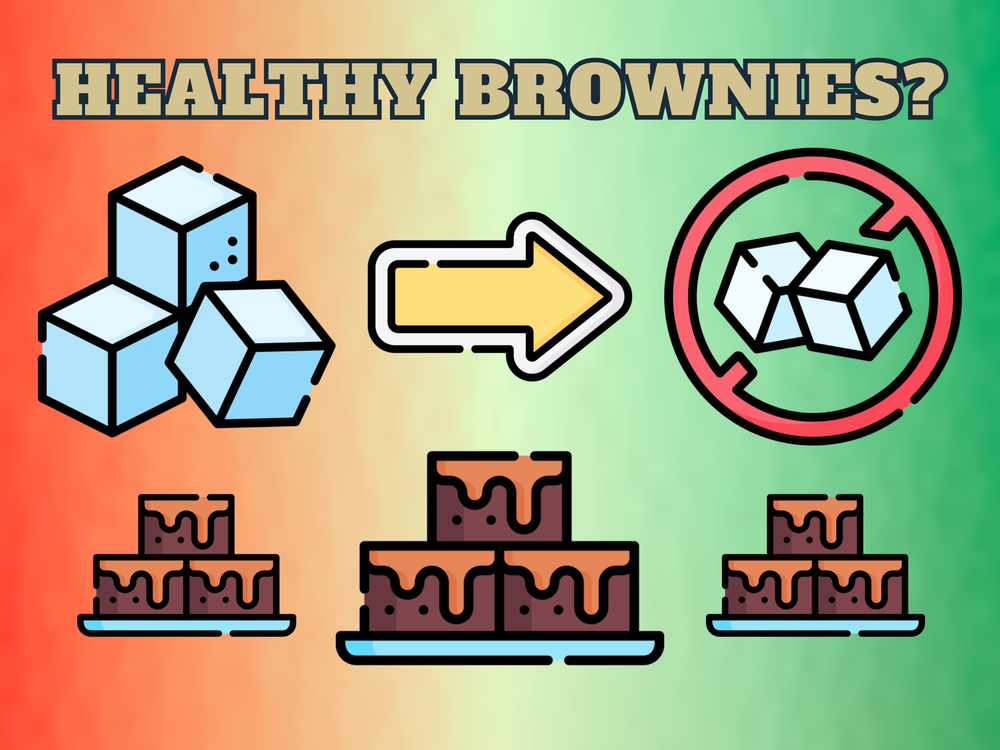
Introduction
I've been wanting to experiment with making healthy versions of classic desserts by swapping out ingredients one by one, analyzing the results, and refining the recipe to end up with a healthier dessert that's as similar as possible to the original product. Today, I'll be tackling brownies, but this will be a 2 part series, with a sister post about chocolate chip cookies. Be sure to check out Making Cookies Healthier when it goes live.


The Problem
Obviously, there's nothing wrong with having a treat like a brownie every now and then. Occasionally at a holiday or gathering, one brownie certainly will not kill you. But if you're someone who has them all the time, then learning to make healthier swaps with minimal difference can be a gamechanger.
For the purposes of this experiment, I will be using my Classic Fudgy Brownies recipe as a starting point. The way I see it, there are 3 health problems with traditional brownies, and most dessert for that matter. These are the following

For reference, below are the ingredients and nutrition facts for my Classic Fudgy Brownies. This is just a standard brownie recipe that I make from time to time, and I figured it would be a good starting place:
These brownies are delicious, don't get me wrong. But with 150 calories, 15 g of added sugar, and 8 g of fat for a fairly small brownie, these can't be more than a once a holiday treat for me. How can we bump up these numbers? (or more accurately, bump them down).
------------------------------------------
Batch 1
Here is my first batch. I wanted to tackle the first bullet point right off the bat, as for me this is most glaring flaw, and possibly the easiest to correct. In place of sugar, I will be using allulose, a zero calorie granular natural sweetener. Below is my list of changes from the original recipe:
As mentioned, the main change was swapping sugar for allulose. I also swapped out the coconut oil and white flour for olive oil and whole wheat flour. I was out of coconut oil at the time, and I figured that for just a tablespoon of oil, it wouldn't really make much of a difference. And I never carry white flour in my house anyway; my original brownies definitely have whole wheat in them despite the what the ingredients say lol. Below is the full list of ingredients for batch 1:
Right off the bat, we knocked out all the sugar and nearly half the calories. There's still a whole stick of butter, and I'm not wild on the whole wheat flour tbh; we can do better. But this is a good first step.
------------------------------------------
Let's bake it and see how batch #1 holds up. For starters, I should go over a few mistakes I made while baking this batch. These were the following:
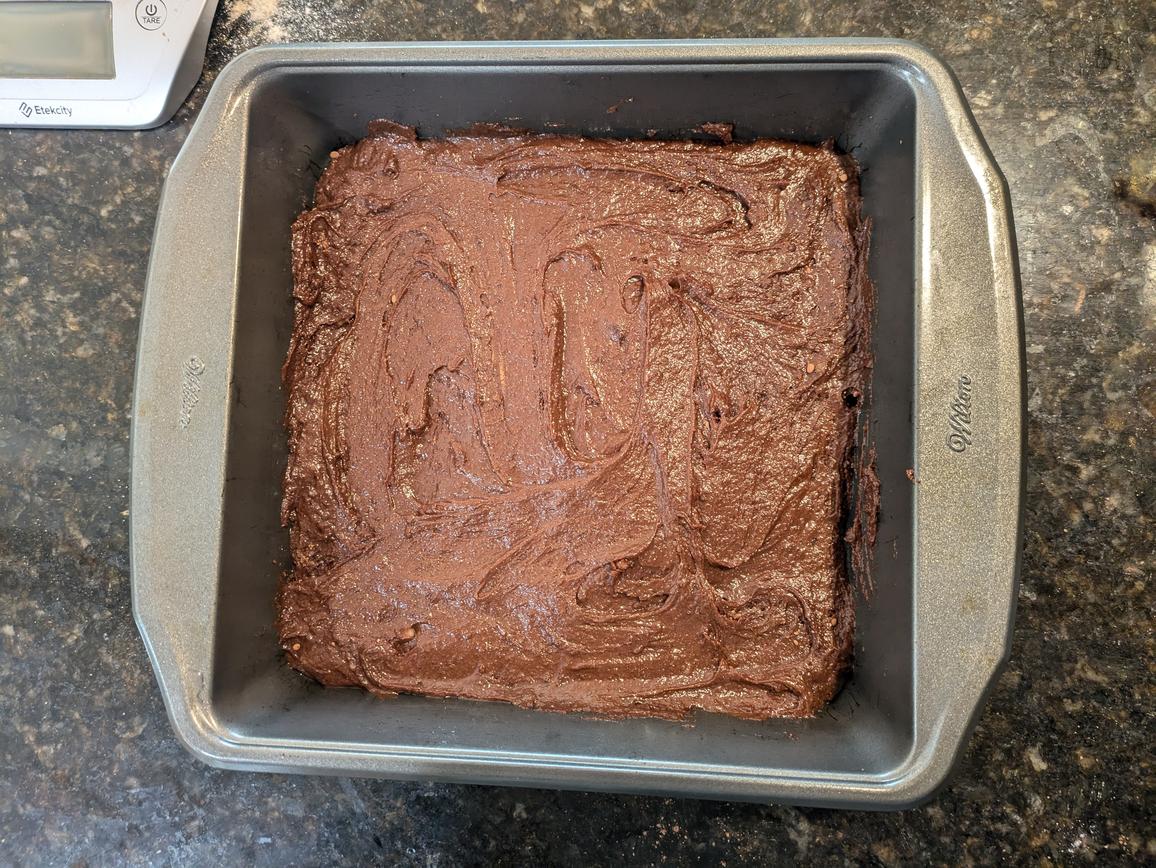
Firstly, using a hand mixer would break down the sweetener more and better combine the batter, but I don't think it made that much of a difference. Brownies without chocolate chips or some other kind of mix in are always a little bit of a disappointment; I'll fix this next time. That second to last bullet point wasn't exactly a mistake, but I think it was unnecessary. Letting the raw batter sit is something I do for classic brownies to help break down the sugar, but I don't think it makes a difference with allulose or some other zero calorie granular sweetener, since we're unlikely to get a brownie skin.
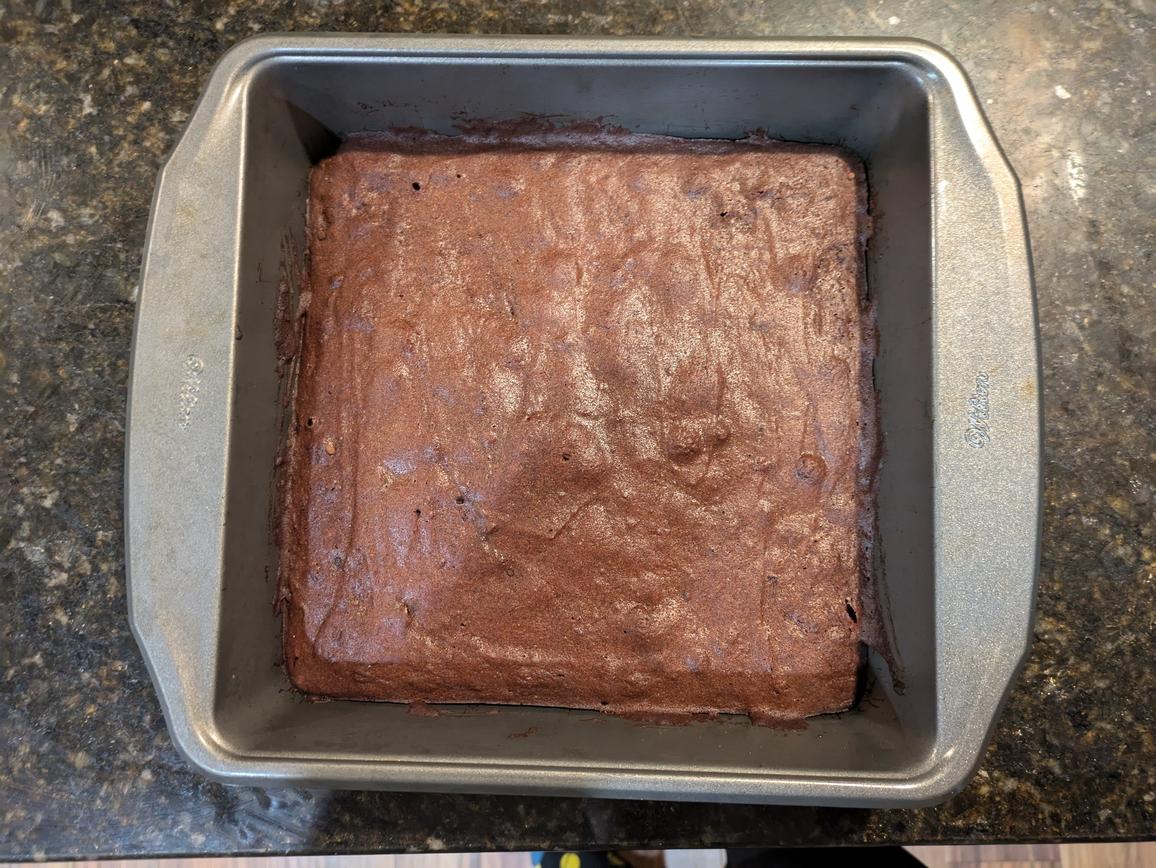
I think that last mistake was the biggest difference. I has my CI pan in the oven because I was seasoning it earlier, forgot about it, and left it in as the brownies baked. As such, the brownies ended up steaming a bit, essentially if I have covered the pan with foil. I think this is the main reason why the tops of the brownies look different than I'd expect.
Because they were steamesd, these brownies felt more cakey than fudgy. It also led to them cooking faster, just 20 minutes. But how do these actually taste. These cut and feel exactly like brownies except for the edges. If you're a crispy edge person, then you probably won't be a fan of these brownies, as it's the sugar that makes it crispy.
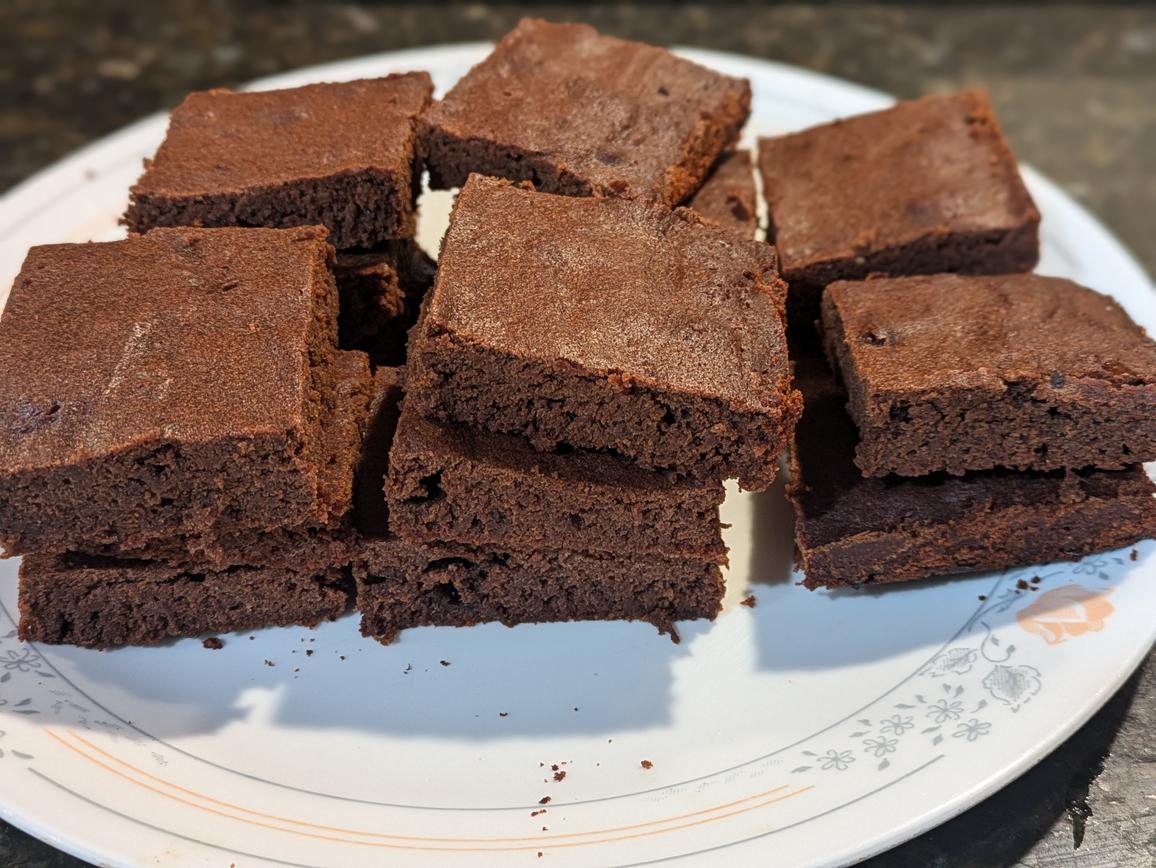
This batch had a great brownie texture and flavor, but they were not very sweet. I tasted the raw batter, and while it was slightly less sweet than regular brownie batter, it was still very sweet. But the sweetness seemed to almost totally vanish when baking. I've never used allulose before, but my guess is that when heated, it looses most of its sweetness. These brownies are still pretty sweet, but not nearly as sweet as you'd expect. They taste like a good healthy dessert, but you can tell it's a healthy dessert.
Possible Next Steps?
As I found out in Fat Replacements in Boxed Brownies and Sweet Potato Boxed Brownies, sweet potato seemed to be the best butter or oil replacement in brownies. But only in keto brownies, as these still have fat from the almond flour. In standard wheat flour based brownies, the removal of fat leads to a lackluster flavor and texture.
Option 2 would be ideal, as it uses more natural ingredients like potatoes and nuts as opposed to oil, and almond flour would be finer as opposed to coarse oat flour. I'll be starting with this route, but I'll make a batch of the first option if this doesn't work out.
Intermission - Chocolate Bar
Back to the drawing board. Firstly, let's tackle the chocolate. I want to have some sort of chocolate chips or chunks for my brownies, so let's make a bar. I'm aiming for semi-sweet chocolate here, which is the following:
A bar of chocolate is essentially just 3 ingredients. Firstly, you have some solid fat, like cocoa butter or coconut oil. Second is the cocoa itself, and lastly is the sweetener. Getting the sugar and fat is the easiest, as all the sugar comes from the sugar, and all the fat comes from the fat. Simple enough.
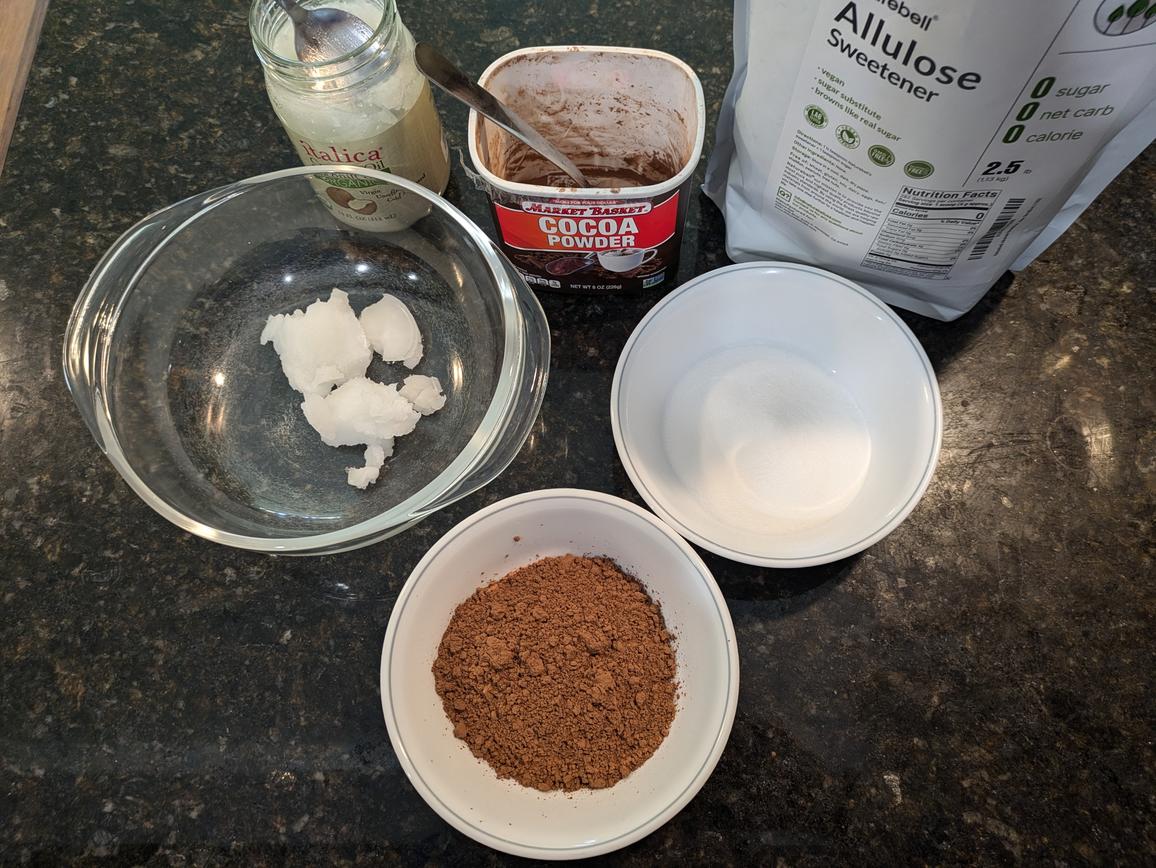
That means, we'll need 6 g of sweetener and 5 g of fat. That leaves us with the remaining 6 g being cocoa powder. If using sugar as the sweetener and coconut oil as the fat, this gets you nearly identical nutrition facts to our original bar. But I'll be going with allulose here instead of sugar. Scaling up to make a full size chocolate bar, we have the following:
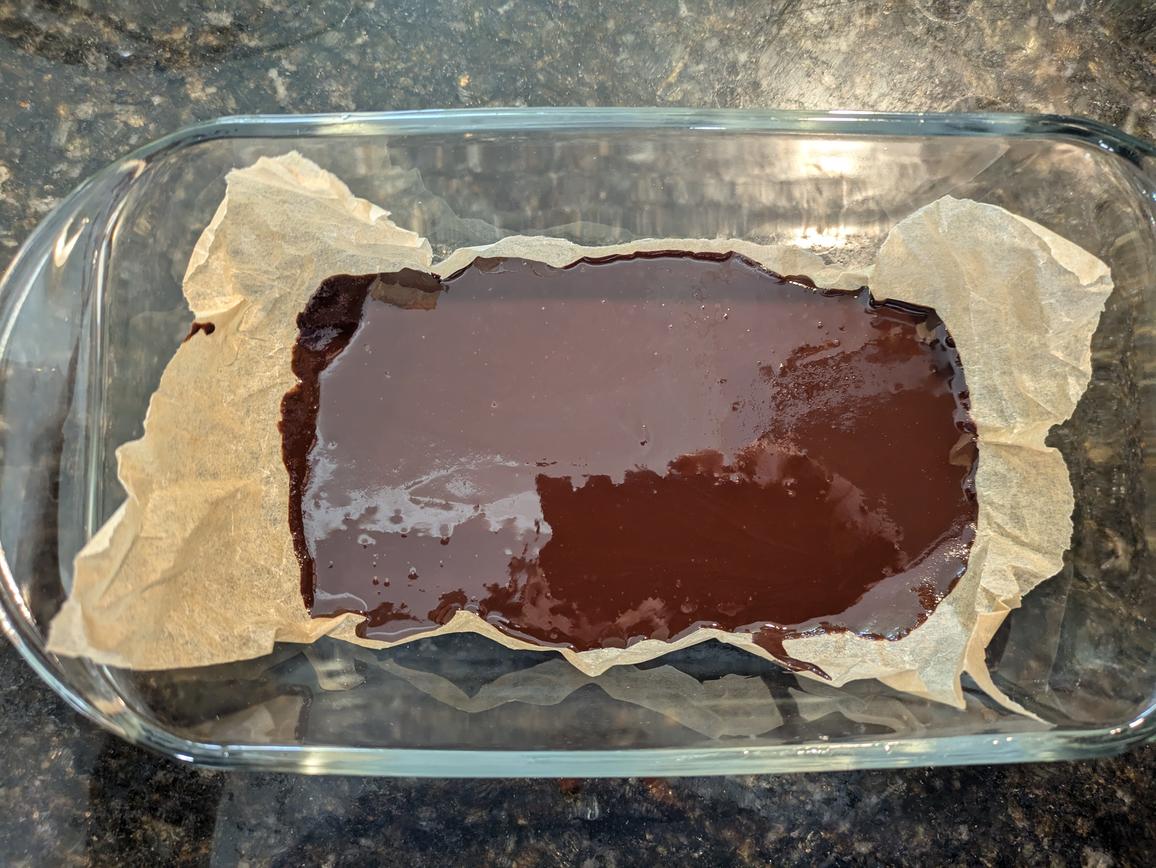
This gets us a bar of chocolate weighting 176 g (about 6 oz). Just melt coconut oil in a bowl, mix in the cocoa and sweetener, and transfer to a chocolate mold or parchment lined bread pan. Refrigerate for an hour to harden, and then chop into chunks.
------------------------------------------
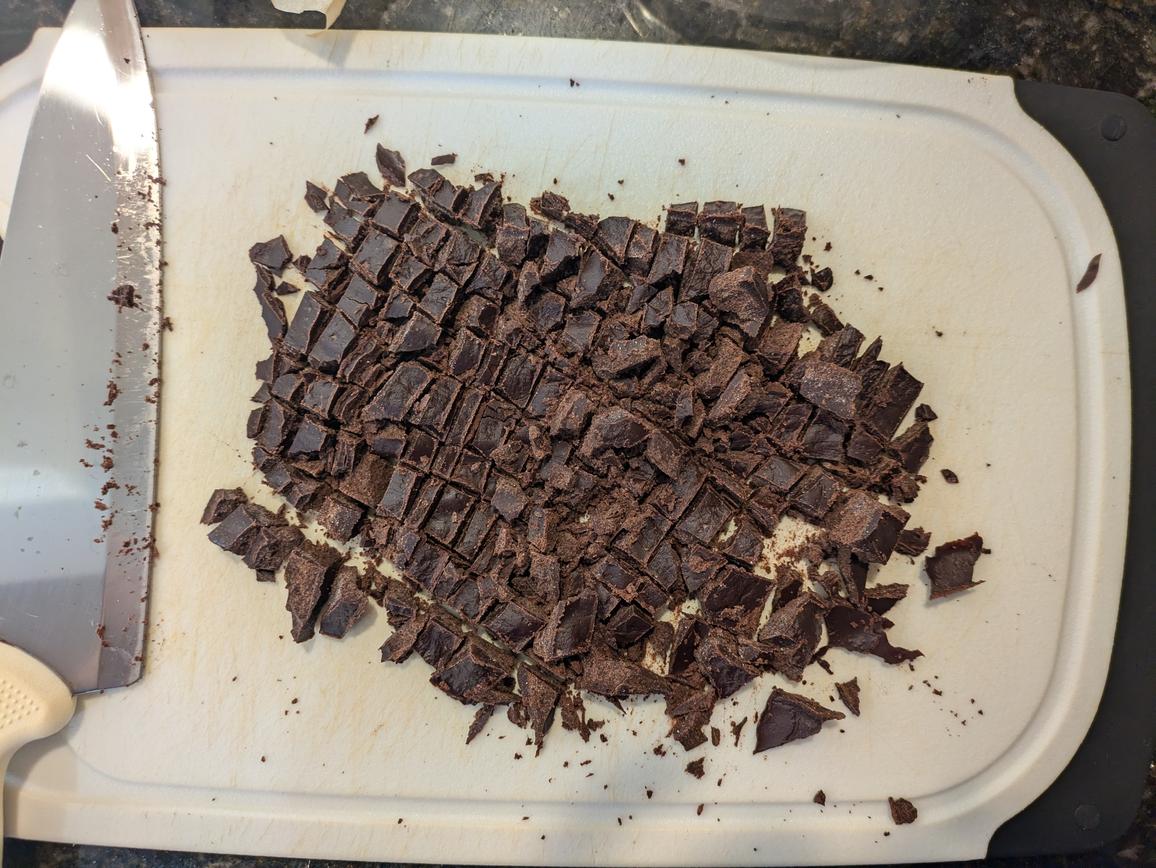
Batch 2
I swear I tried to only change one or two amall things for this batch, but I got carried away lol. Here's a summary of my changes:
You may be wondering, where is the cocoa powder? That's a great question; I ran out lmao. I swapped the cocoa powder for oat flour, and made these into blondies instead. Everything else is a fairly reasonable substitution.
I swapped the butter for sweet potato to reduce the unhealthy fats, but I included nut butter and almond flour to still have some fat. I decreased the allulose, as most keto brownie recipes only called for a cup. But I supplemented with some monk fruit to help boost the sweetness. I also wanted a bit more salt to make up for them being less sweet than traditional.

Don't worry, I learned from my mistakes this time. I broke out the electric mixer, and I took the cast iron out of the oven this time. These blondies took 25 minutes to bake at 350F in a parchment lined 9" square pan. So how did thebrownies blondies turn out then?
Not only are these healthier than the first batch, containing less refined flour and animal fats, but they also tasted better. As predicted, the addition of sweet potato and monk fruit brought up the sweetness in the bars. The peanut butter and sweet potato helped keep the blondies moist and fudgy without butter or oil, and the pockets of chopped dark chocolate added great flavor and textural contrast.

This batch contained less carbs, more healthy fats, and had slightly more protein and fiber. Because of the chopped chocolate, there's slightly more calories than the first batch, but I'll gladly take that tradeoff. Fat and calories aren't inherently bad; they depend on the source (nuts > butter).
------------------------------------------

Conclusion
Honestly, I won't be baking with allulose again. It loses all it's sweetness when baked, doesn't spread or brown like sugar (despite what it says on the bag), and is expensive. There was some improvement though; the blondies of batch #2 were definitely better than the brownies of batch #1, but they pale in comparison to any of my other healthier desserts, let alone a batch of regular brownies. Below are some other recipes I'd recommend you try instead of these:
My main takeaway from this honestly though is that I can't digest allulose. Some people are totally fine with it, but other seem to get side effects like an upset stomach, bloating, constipation, nausea, or diarrhea. I personally fall into the latter, getting bloating and a stomach ache from just 1 brownie, so I personally won't be making these again.
Sources
This post may contain affiliate links
I've been wanting to experiment with making healthy versions of classic desserts by swapping out ingredients one by one, analyzing the results, and refining the recipe to end up with a healthier dessert that's as similar as possible to the original product. Today, I'll be tackling brownies, but this will be a 2 part series, with a sister post about chocolate chip cookies. Be sure to check out Making Cookies Healthier when it goes live.


The Problem
Obviously, there's nothing wrong with having a treat like a brownie every now and then. Occasionally at a holiday or gathering, one brownie certainly will not kill you. But if you're someone who has them all the time, then learning to make healthier swaps with minimal difference can be a gamechanger.
For the purposes of this experiment, I will be using my Classic Fudgy Brownies recipe as a starting point. The way I see it, there are 3 health problems with traditional brownies, and most dessert for that matter. These are the following
- Added sugars
- Butter or highly refined oils
- Processed white flour

For reference, below are the ingredients and nutrition facts for my Classic Fudgy Brownies. This is just a standard brownie recipe that I make from time to time, and I figured it would be a good starting place:
- 1/2 cup (112 g) Unsalted butter
- 1 tbsp (14 g) Extra virgin coconut oil
- 2 cup (240 g) Powdered sugar
- 2 large (101 g) Egg
- 1 tsp (5 g) Vanilla extract
- 1/4 tsp (1.5 g) Salt
- 1/2cup + 1tbsp (45 g) Cocoa powder
- 1/2 cup (60 g) All purpose flour
These brownies are delicious, don't get me wrong. But with 150 calories, 15 g of added sugar, and 8 g of fat for a fairly small brownie, these can't be more than a once a holiday treat for me. How can we bump up these numbers? (or more accurately, bump them down).
------------------------------------------
Total Fat: 7.6g (10 %)
Sodium: 46mg (2 %)
Total Carbohydrate: 19.6g (7 %)
Fiber: 1.2g (4 %)
Net Carbs: 18.4g
Total Sugar: 14.8g
Added Sugar: 14.8g (30 %)
Protein: 1.8g (4 %)
Total Fat: 7.6g (10 %)
Sodium: 46mg (2 %)
Total Carbohydrate: 19.6g (7 %)
Fiber: 1.2g (4 %)
Net Carbs: 18.4g
Total Sugar: 14.8g
Added Sugar: 14.8g (30 %)
Protein: 1.8g (4 %)
Batch 1
Here is my first batch. I wanted to tackle the first bullet point right off the bat, as for me this is most glaring flaw, and possibly the easiest to correct. In place of sugar, I will be using allulose, a zero calorie granular natural sweetener. Below is my list of changes from the original recipe:
- Swapped sugar for allulose at a 1:1 ratio by weight
- Used olive oil instead of coconut oil
- Used whole wheat flour instead of white flour
As mentioned, the main change was swapping sugar for allulose. I also swapped out the coconut oil and white flour for olive oil and whole wheat flour. I was out of coconut oil at the time, and I figured that for just a tablespoon of oil, it wouldn't really make much of a difference. And I never carry white flour in my house anyway; my original brownies definitely have whole wheat in them despite the what the ingredients say lol. Below is the full list of ingredients for batch 1:
- 1 stick (113 g) Unsalted butter
- 1 tbsp (15 g) Extra virgin olive oil
- 1.25 cup (240 g) Allulose
- 2 large (101 g) Egg
- 1 tsp (5 g) Vanilla extract
- 1/4 tsp (1.5 g) Salt
- 1/2cup + 1tbsp (45 g) Cocoa powder
- 1/2 cup (60 g) Whole wheat flour
Right off the bat, we knocked out all the sugar and nearly half the calories. There's still a whole stick of butter, and I'm not wild on the whole wheat flour tbh; we can do better. But this is a good first step.
------------------------------------------
Total Fat: 7.8g (10 %)
Sodium: 46mg (2 %)
Total Carbohydrate: 19.4g (7 %)
Fiber: 1.4g (5 %)
Net Carbs: 3.0g
Total Sugar: 0.1g
Allulose: 15.0g
Protein: 1.9g (4 %)
Total Fat: 7.8g (10 %)
Sodium: 46mg (2 %)
Total Carbohydrate: 19.4g (7 %)
Fiber: 1.4g (5 %)
Net Carbs: 3.0g
Total Sugar: 0.1g
Allulose: 15.0g
Protein: 1.9g (4 %)
Let's bake it and see how batch #1 holds up. For starters, I should go over a few mistakes I made while baking this batch. These were the following:
- I mixed the ingredients with a silicone spatula instead of a hand mixer
- No chocolate chips (brownies are always better with chocolate chips)
- I left the raw batter in the pan for about 6 hours before baking
- I accidentally left my cast iron pan in the oven on the rack above

Firstly, using a hand mixer would break down the sweetener more and better combine the batter, but I don't think it made that much of a difference. Brownies without chocolate chips or some other kind of mix in are always a little bit of a disappointment; I'll fix this next time. That second to last bullet point wasn't exactly a mistake, but I think it was unnecessary. Letting the raw batter sit is something I do for classic brownies to help break down the sugar, but I don't think it makes a difference with allulose or some other zero calorie granular sweetener, since we're unlikely to get a brownie skin.

I think that last mistake was the biggest difference. I has my CI pan in the oven because I was seasoning it earlier, forgot about it, and left it in as the brownies baked. As such, the brownies ended up steaming a bit, essentially if I have covered the pan with foil. I think this is the main reason why the tops of the brownies look different than I'd expect.
Because they were steamesd, these brownies felt more cakey than fudgy. It also led to them cooking faster, just 20 minutes. But how do these actually taste. These cut and feel exactly like brownies except for the edges. If you're a crispy edge person, then you probably won't be a fan of these brownies, as it's the sugar that makes it crispy.

This batch had a great brownie texture and flavor, but they were not very sweet. I tasted the raw batter, and while it was slightly less sweet than regular brownie batter, it was still very sweet. But the sweetness seemed to almost totally vanish when baking. I've never used allulose before, but my guess is that when heated, it looses most of its sweetness. These brownies are still pretty sweet, but not nearly as sweet as you'd expect. They taste like a good healthy dessert, but you can tell it's a healthy dessert.
Possible Next Steps?
- Replace the butter for coconut oil, and swap the wheat flour for oat flour
- Replace the butter for some lower fat replacement, and swap the wheat flour for almond flour
As I found out in Fat Replacements in Boxed Brownies and Sweet Potato Boxed Brownies, sweet potato seemed to be the best butter or oil replacement in brownies. But only in keto brownies, as these still have fat from the almond flour. In standard wheat flour based brownies, the removal of fat leads to a lackluster flavor and texture.
Option 2 would be ideal, as it uses more natural ingredients like potatoes and nuts as opposed to oil, and almond flour would be finer as opposed to coarse oat flour. I'll be starting with this route, but I'll make a batch of the first option if this doesn't work out.
Intermission - Chocolate Bar
Back to the drawing board. Firstly, let's tackle the chocolate. I want to have some sort of chocolate chips or chunks for my brownies, so let's make a bar. I'm aiming for semi-sweet chocolate here, which is the following:
A bar of chocolate is essentially just 3 ingredients. Firstly, you have some solid fat, like cocoa butter or coconut oil. Second is the cocoa itself, and lastly is the sweetener. Getting the sugar and fat is the easiest, as all the sugar comes from the sugar, and all the fat comes from the fat. Simple enough.

That means, we'll need 6 g of sweetener and 5 g of fat. That leaves us with the remaining 6 g being cocoa powder. If using sugar as the sweetener and coconut oil as the fat, this gets you nearly identical nutrition facts to our original bar. But I'll be going with allulose here instead of sugar. Scaling up to make a full size chocolate bar, we have the following:
- 1/4 cup (54 g) Extra virgin coconut oil
- 1/2cup + 2tbsp (50 g) Cocoa powder
- 6 tbsp (72 g) Allulose

This gets us a bar of chocolate weighting 176 g (about 6 oz). Just melt coconut oil in a bowl, mix in the cocoa and sweetener, and transfer to a chocolate mold or parchment lined bread pan. Refrigerate for an hour to harden, and then chop into chunks.
------------------------------------------
Total Fat: 5.2g (7 %)
Sodium: 1mg (0 %)
Total Carbohydrate: 8.4g (3 %)
Fiber: 1.5g (6 %)
Net Carbs: 0.9g
Total Sugar: 0.1g
Allulose: 6.0g
Protein: 0.8g (2 %)
Total Fat: 5.2g (7 %)
Sodium: 1mg (0 %)
Total Carbohydrate: 8.4g (3 %)
Fiber: 1.5g (6 %)
Net Carbs: 0.9g
Total Sugar: 0.1g
Allulose: 6.0g
Protein: 0.8g (2 %)

Batch 2
I swear I tried to only change one or two amall things for this batch, but I got carried away lol. Here's a summary of my changes:
- Replaced 1 stick (113 g) butter for 1/2 cup (120 g) sweet potato puree
- Replaced 1 tbsp (14 g) oil with 1/4 cup (64 g) peanut butter
- Reduced allulose from 1.25 cups (240 g) to 1 cup (200 g)
- Added 1/2 tsp (2.5 g) liquid monk fruit
- Increased salt from 1/4 tsp (1.5 g) to 1/2 tsp (3 g)
- Swapped 1/2 cup (40 g) cocoa powder for 1/2 cup (45 g) oat flour
- Swapped 1/2 cup (60 g) flour for 1/2 cup (56 g) almond flour
- Folded in 1/2 cup (90 g) chopped chocolate
You may be wondering, where is the cocoa powder? That's a great question; I ran out lmao. I swapped the cocoa powder for oat flour, and made these into blondies instead. Everything else is a fairly reasonable substitution.
- 1/2 cup (120 g) Sweet potato puree
- 1/4 cup (64 g) Natural peanut butter
- 1 cup (200 g) Allulose
- 2 large (101 g) Egg
- 1/2 tsp (3 g) Salt
- 1 tsp (5 g) Vanilla extract
- 1/2 tsp (2.5 g) Liquid monk fruit
- 1/2 cup (56 g) Almond flour
- 1/2 cup (45 g) Oat flour
- 1/2 cup, chopped (90 g) Allulose chocolate bar
I swapped the butter for sweet potato to reduce the unhealthy fats, but I included nut butter and almond flour to still have some fat. I decreased the allulose, as most keto brownie recipes only called for a cup. But I supplemented with some monk fruit to help boost the sweetness. I also wanted a bit more salt to make up for them being less sweet than traditional.

Don't worry, I learned from my mistakes this time. I broke out the electric mixer, and I took the cast iron out of the oven this time. These blondies took 25 minutes to bake at 350F in a parchment lined 9" square pan. So how did the
Not only are these healthier than the first batch, containing less refined flour and animal fats, but they also tasted better. As predicted, the addition of sweet potato and monk fruit brought up the sweetness in the bars. The peanut butter and sweet potato helped keep the blondies moist and fudgy without butter or oil, and the pockets of chopped dark chocolate added great flavor and textural contrast.

This batch contained less carbs, more healthy fats, and had slightly more protein and fiber. Because of the chopped chocolate, there's slightly more calories than the first batch, but I'll gladly take that tradeoff. Fat and calories aren't inherently bad; they depend on the source (nuts > butter).
------------------------------------------
Total Fat: 6.6g (8 %)
Sodium: 101mg (4 %)
Total Carbohydrate: 20.8g (8 %)
Fiber: 1.8g (6 %)
Net Carbs: 4.2g
Total Sugar: 1.0g
Allulose: 14.8g
Protein: 3.4g (7 %)
Total Fat: 6.6g (8 %)
Sodium: 101mg (4 %)
Total Carbohydrate: 20.8g (8 %)
Fiber: 1.8g (6 %)
Net Carbs: 4.2g
Total Sugar: 1.0g
Allulose: 14.8g
Protein: 3.4g (7 %)

Conclusion
Honestly, I won't be baking with allulose again. It loses all it's sweetness when baked, doesn't spread or brown like sugar (despite what it says on the bag), and is expensive. There was some improvement though; the blondies of batch #2 were definitely better than the brownies of batch #1, but they pale in comparison to any of my other healthier desserts, let alone a batch of regular brownies. Below are some other recipes I'd recommend you try instead of these:
My main takeaway from this honestly though is that I can't digest allulose. Some people are totally fine with it, but other seem to get side effects like an upset stomach, bloating, constipation, nausea, or diarrhea. I personally fall into the latter, getting bloating and a stomach ache from just 1 brownie, so I personally won't be making these again.
Sources